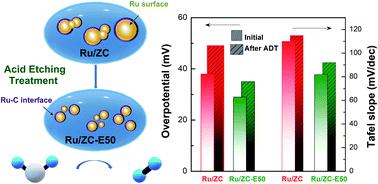当前位置:
X-MOL 学术
›
J. Mater. Chem. A
›
论文详情
Our official English website, www.x-mol.net, welcomes your
feedback! (Note: you will need to create a separate account there.)
Revealing and magnifying interfacial effects between ruthenium and carbon supports for efficient hydrogen evolution
Journal of Materials Chemistry A ( IF 10.7 ) Pub Date : 2022-08-02 , DOI: 10.1039/d2ta04268a Yongjun Jiang, Ting-Wei Huang, Hsuan-Lien Chou, Lihui Zhou, Sheng-Wei Lee, Kuan-Wen Wang, Sheng Dai
Journal of Materials Chemistry A ( IF 10.7 ) Pub Date : 2022-08-02 , DOI: 10.1039/d2ta04268a Yongjun Jiang, Ting-Wei Huang, Hsuan-Lien Chou, Lihui Zhou, Sheng-Wei Lee, Kuan-Wen Wang, Sheng Dai

|
Ru has been considered as a highly efficient material for the hydrogen evolution reaction (HER) and becomes one of the promising alternatives to Pt owing to its relatively low price and similar hydrogen bonding strength. Carbon host materials, e.g., amorphous carbon (AC), porous carbon (PC), and ZIF-derived carbon (ZC), are widely used in Ru/C catalysts. Here, we investigate the influences of the above three different carbon host materials over the supported Ru species in Ru/C catalysts. A stronger metal–support interaction is revealed in the Ru/ZC catalyst, in which the supported Ru species are preserved in a metallic state and a highly dispersed form, resulting in enhanced HER activity and stability in alkaline media. Both the Ru sites and Ru–C interfacial sites are determined to be active for the HER in Ru/ZC according to our electrochemical poisoning experiment. In addition, an acid etching treatment (AET) strategy is proposed to magnify the interfacial effect of Ru/C catalysts for further HER improvement, and the optimal Ru/ZC-E50 catalyst that undergoes appropriate etching treatment shows a smaller Ru size and more exposed Ru–C interface, realizing an overpotential of only 29 mV (at 10 mA cm−2) and a Tafel slope of 82 mV dec−1 that greatly outperform those of Ru-based and Pt-based materials for the HER in alkaline media. These specific findings can provide deeper insights into the design strategy, structure–property relationship, and future development of Ru/C catalysts for efficient HER.
中文翻译:

揭示和放大钌和碳载体之间的界面效应,以实现高效析氢
Ru被认为是一种高效的析氢反应(HER)材料,并且由于其相对较低的价格和相似的氢键强度而成为Pt的有希望的替代品之一。碳主体材料,例如、无定形碳(AC)、多孔碳(PC)和ZIF衍生碳(ZC)广泛用于Ru/C催化剂。在这里,我们研究了上述三种不同的碳主体材料对Ru/C催化剂中负载的Ru物种的影响。在Ru/ZC催化剂中显示出更强的金属-载体相互作用,其中负载的Ru物质保持金属状态和高度分散的形式,从而提高了碱性介质中的HER活性和稳定性。根据我们的电化学中毒实验,Ru 位点和 Ru-C 界面位点都被确定为对 Ru/ZC 中的 HER 具有活性。此外,提出了一种酸蚀刻处理(AET)策略来放大Ru/C催化剂的界面效应,从而进一步改善HER,-2 ) 和 82 mV dec -1的 Tafel 斜率,其在碱性介质中的 HER 性能大大优于 Ru 基和 Pt 基材料。这些具体发现可以为高效 HER 的 Ru/C 催化剂的设计策略、结构-性能关系和未来发展提供更深入的见解。
更新日期:2022-08-02
中文翻译:

揭示和放大钌和碳载体之间的界面效应,以实现高效析氢
Ru被认为是一种高效的析氢反应(HER)材料,并且由于其相对较低的价格和相似的氢键强度而成为Pt的有希望的替代品之一。碳主体材料,例如、无定形碳(AC)、多孔碳(PC)和ZIF衍生碳(ZC)广泛用于Ru/C催化剂。在这里,我们研究了上述三种不同的碳主体材料对Ru/C催化剂中负载的Ru物种的影响。在Ru/ZC催化剂中显示出更强的金属-载体相互作用,其中负载的Ru物质保持金属状态和高度分散的形式,从而提高了碱性介质中的HER活性和稳定性。根据我们的电化学中毒实验,Ru 位点和 Ru-C 界面位点都被确定为对 Ru/ZC 中的 HER 具有活性。此外,提出了一种酸蚀刻处理(AET)策略来放大Ru/C催化剂的界面效应,从而进一步改善HER,-2 ) 和 82 mV dec -1的 Tafel 斜率,其在碱性介质中的 HER 性能大大优于 Ru 基和 Pt 基材料。这些具体发现可以为高效 HER 的 Ru/C 催化剂的设计策略、结构-性能关系和未来发展提供更深入的见解。











































 京公网安备 11010802027423号
京公网安备 11010802027423号